Enhanced TDS
Identification & Functionality
- Chemical Family
- RTU Product Type
- Technologies
- Product Families
Features & Benefits
- Ready-to-Use Product Features
- Key Properties
- Good mechanical and electrical end properties
- Very high thermal endurance properties
- Considerable insensitivity to atmospheric and chemical influences.
Applications & Uses
- Application Area
- Composites Processing Methods
- Product End Uses
- Markets
- Applications
- Processing Methods
- Conventional gravity casting process under vacuum.
- Adjustable to existing handling parameters.
- Remarks
- Hardener Aradur HY 905 IN is sensitive to humidity and tends at low storage temperature to crystallize. It can be reliquefied by stirring and heating it to 40 - 80°C.
- Processing Information
General instructions for preparing liquid resin systems
- Long pot life is desirable in the processing of any casting resin system. Mix all of the components together very thoroughly at room temperature or slightly above and under vacuum. Intensive wetting of the filler is extremely important. Proper mixing will result in:
- better flow properties and reduced tendency to shrinkage
- lower internal stresses and therefore improved mechanical properties on object
- improved partial diskharge behavior in high voltage applications.
- For the mixing of medium- to high viscous casting resin systems and for mixing at lower temperatures, we recommend special thin film degassing mixers that may produce additional self-heating of 10-15 K as a result of friction.
- For low viscous casting resin systems, conventional anchor mixers are usually sufficient. In larger plants, two premixers are used to mix the individual components (resin, hardener) with the respective quantities of fillers and additives under vacuum. Metering pumps then feed these premixes to the final mixer or a continuous mixer. The individual premixes can be stored at elevated temperature (about 60°C) for up to about 1 week, de-pending on formulation.
Note: A premix of accelerator with resin is not stable; a premix of accelerator with hardener is stable under certain conditions.
- Mixing time can vary from 0.5 to 3 hours, depending on mixing temperature, quantity, mixing equipment and the particular application. The required vacuum is 0.5 to 5 mbar. The vapor pressure of the individual components should be taken into account. In the case of dielectrically highly stressed parts, we recommend checking the quality consistency and predrying of the filler. Their moisture content should be < 0.2%.
Specific instructions
The effective pot-life of the mix is about 1 day at temperatures below 25°C. Conventional batch mixers should be cleaned once a week or at the end of work. For longer interruptions of work, the pipes of the mixing and metering installllations have to be cooled and cleaned with the resin component to prevent sedimentation and/or undesired viscosity increase. Interruptions over a week-end (approx. 48h) without cleaning are possible if the pipes are cooled at temperatures below 18°C.
In case to use mixtures with high reactivity, we recommend to clean daily with the flexibilizer DY 040. Viscosity increase and gel time at various temperatures.
Mold temperature
Conventional vacuum casting - 80 - 100°C
Demolding times (depending on mold temperature and casting volume)
Conventional vacuum casting - 6 - 12h
Cure conditions (minimal postcure)
Conventional Vacuum Casting - 6h at 80°C + 10h at 130°C or 6h at 80°C + 6h at 140°C
Castings with big volume (exothermic reaction, internal mechanical stresses) or encapsulations of heat sensitive active parts could be cured at appr. 80°C.
To determine whether crosslinking has been carried to completion and the final proper-ties are optimal, it is necessary to carry out relevant measurements on the actual object or to measure the glass transition temperature(Tg). Different gelling and cure cycles in the manufacturing process could lead to a different crosslinking and glass transition temperature respectively.- Application Information
Indoor electrical insulators for medium and high voltage, such as post insulators, bushings, switch and apparatus components as well as instrument transformers and dry type distribution transformers.
Properties
- Physical Form
- Processing Viscosities

Fig.4.1: Viscosity increase at 40 and 60°C (measurements with Rheomat 115)
(Shear rate D = 10 s-1)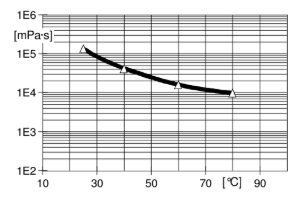
Fig.4.2: Initial viscosity as a function of temperature
(measurements with Rheomat 115, D =10 s-1)
Technical Details & Test Data
- Electrical Properties
System tested:
Araldite CY 205 IN / HY 905 IN / DY 040 / DY 061 / Silica.
Mix ratio: 100 / 100 / 10 / 1 / 410.
Determined on standard test specimen at 23°C.
Cured for 6h at 80°C + 10h at 130°C.Property
Test Method
Unit
Value Range
Breakdown strength
IEC 60243-1
kV/mm
18 - 22
Breakdown strength (embedded Rogowski electrodes)
Huntsman method
kV/mm
36 - 41
Diffusion breakdown strength
DIN/VDE 0441/1
class
HD 2
Temperature of specimen after test
-
°C
23
HV arc resistance
IEC 61621
s
185 - 195
Tracking resistance (with test solution A)
-
CTI
> 600-0.0
Tracking resistance (with test solution B)
-
CTI
> 600M-0.0
Electrolytic corrosion
IEC 60426
grade
A-1
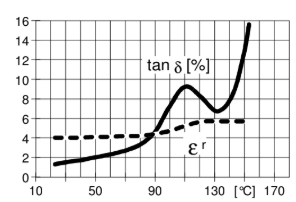
Fig.6.1: Loss factor (tan δ) and dielectric constant (εr) as a function of temperature measurement frequency: 50 Hz, (IEC 60250/ DIN 53483)
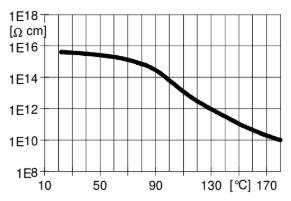
Fig.6.2: Volume resistivity (ρ) versus function of temperature (measurement voltage: 1000 V, IEC 60093/ DIN 53482)
- Gelation / Cure Time
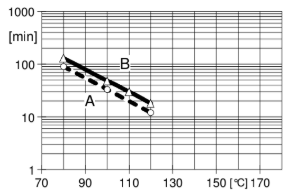
Fig.4.4: Geltime measured with Gelnorm Instrument as a function of temperature (ISO 9396)
A = 1 pbw DY 061 / B = 0.5 pbw DY 061.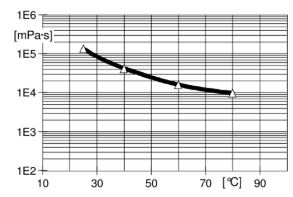
Fig.4.5: Glass transition temperature as a function of the cure time
(isothermic reaction, ISO 11357-2)- Mechanical & Physical Properties
Araldite CY 205 IN / HY 905 IN / DY 040 / DY 061 / Silica.
Mix ratio: 100 / 100 / 10 / 1 / 410, cured for 6h at 80°C + 10h at 130°C.
Determined on standard test specimen at 23°C.Property
Test Method
Unit
Value Range
Tensile strength
ISO 527
MPa
75 - 85
Elongation at break
ISO 527
%
0.9 - 1.1
E modulus from tensile test
ISO 527
MPa
12000 - 13000
Flexural strength
ISO 178
MPa
125 - 135
Surface strain
ISO 178
%
1.1 - 1.5
E modulus from flexural test
ISO 178
MPa
11600 - 12000
Compressive strength
ISO 604
MPa
140 - 150
Compression set
ISO 604
%
6 - 7
Impact strength
ISO 179
kJ/m²
10 - 12
Double Torsion Test
CG 216-0/89
-
-
Critical stress intensity factor (K1C)
-
MPa·m½
2.7 - 2.9
Specific energy at break (G1C)
-
J/m²
570 - 620
Martens temperature
DIN 53458
°C
80 - 90
Glass transition temperature (DSC)
ISO 11357-2
°C
85 - 95
Coefficient of linear thermal expansion
ISO 11359-2
K⁻¹
31 - 36·10⁻⁶
Thermal conductivity
ISO 8894-1
W/mK
0.8 - 0.9
Glow resistance
DIN 53459
class
2b
Flammability
UL 94
class
HB, V1
Thermal endurance profile (TEP)
IEC 60216
-
Fig. 7.1 - 7.2
Temperature index (TI)
-
°C
164 / 187
Thermal ageing class (20000h)
IEC 60085
class
F
Water absorption (specimen: 50x50x4 mm)
IEC 60062
% by wt.
0.10 - 0.20
Decomposition temperature
DTA
°C
> 350
Density (Filler load: 66 % by wt.)
ISO 1183
g/cm³
1.80 - 1.90
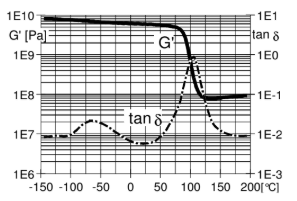
Fig.5.1: Shear modulus (G') and mechanical loss- factor (tan δ) as a function of temperature (measured at 1 Hz.)
(ISO 6721-7, method C)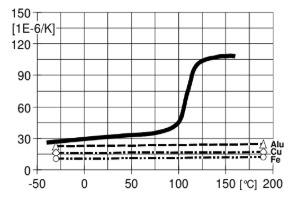
Fig.5.2: Coefficient of linear thermal expansion (α) as a function of temperature
(ISO 11359-2, reference temperature: 23°C)- Special Properties
Thermal Endurance Profile IEC 60216
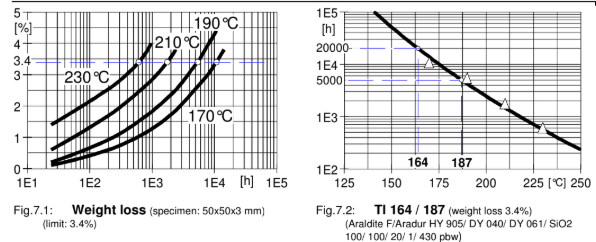
Influence of Flexibilizer DY 040

Glass transition temperature
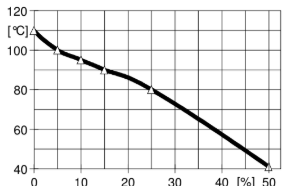
Thermal Shock Resistance
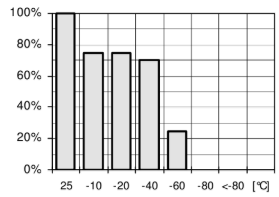
Fig.7.5:Crack resistance / Temperature shock test
Passed specimen (%) as a function of the temperature steps
Mean failure temperature: - 49°C
Embedded metal parts with 2 mm radius
Storage & Handling
- Storage Conditions
Store the components in a dry place according to the storage conditions stated on the label in tightly sealed original containers. Under these conditions, the shelf life will correspond to the expiry date stated on the label. After this date, the product may be processed only after reanalysis. Partly emptied containers should be tightly closed immediately after use.
Other
- Application Information
Value Units Test Method / Conditions Mix Ratio 0.01 %(W) %(W) Accelerator : Resin Mix Ratio 4.1 %(W) %(W) Filler : Resin Mix Ratio 0.1 %(W) %(W) Flexibilizer : Resin Mix Ratio 1.0 %(W) %(W) Hardener : Resin
